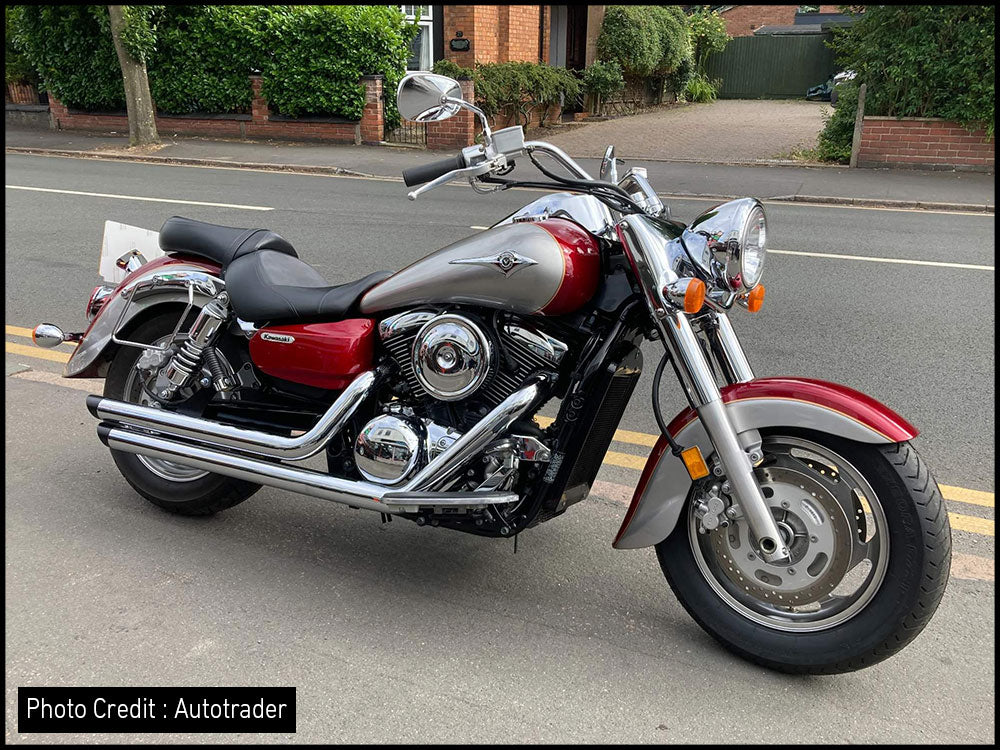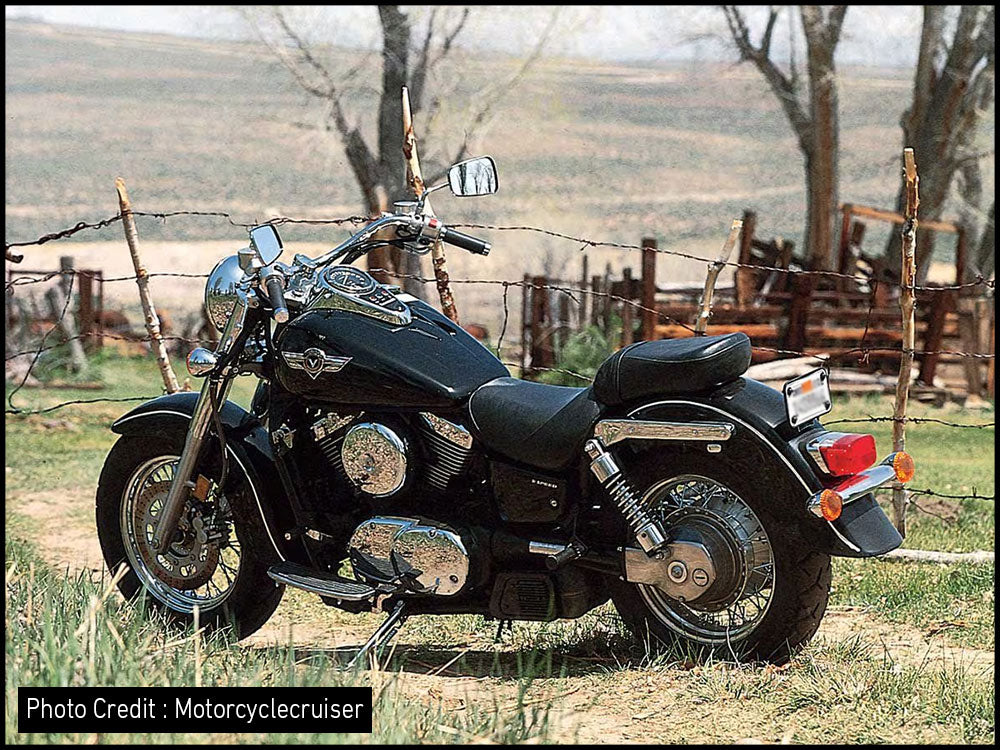Environmentalists choose motorcycles over cars because they believe that motorcycles cause less pollution and traffic, which will lessen the impact on the environment.
With the hustle and bustle of the city, traveling by motorbike can be useful and convenient, allowing you to easily cut through any congested traffic. Going for long rides excites riders. They love their bikes because it is easy to maneuver in the city and fun to ride on long motorcycle roads. Motorcyclists also benefit from better parking options and low maintenance costs.
If you are one of those riders who own a bike that suits your style both for everyday commutes and long tours, you need a cruiser with a comfortable riding position, softer suspension, and a muscular engine capable of going anywhere. In this post, you will learn about a motorcycle that will satisfy all your expectations, the Kawasaki Vulcan 1600 Classic.
Read on to find out everything you want to know, including specs, background, performance, and more about the Kawaski Vulcan 1600 Classic.
Table of Content
1. A Brief History Of Kawasaki Vulcan 1600 Classic
The Vulcan motorcycle is a family of cruiser motorcycles produced by Kawasaki that first made its debut in 1985 with the release of the Kawasaki Vulcan 750. These were the most stylish and comfortable cruisers ever built, built with sporty looks and quite similar in design to the Kawasaki Ninja. Even after all this time, they've been incredibly popular.
Kawasaki motorcycles have an impressive legacy, despite the evolution of their models over the decades. Keeping up with the times, the company has been successful because it modernizes its motorcycles. The Kawasaki Vulcan family features several variants, which range from 400cc to 2053cc engine displacements, most of which were fitted with V-Twin engines.
Shortly after being introduced to the market, the U.S. imposed import limitations on Japanese motorcycles with engine displacements larger than 700ccs. So Kawasaki reduced the size of the original Vulcan to 699cc until the restrictions were lifted in 1986. The Vulcan 750 was powered by a liquid-cooled, DOHC, V-Twin engine.
In 1990, the company launched the smallest of the Vulcan models, the VN500, which was built with an air-cooled 498cc parallel-twin engine. This model was an entry-level model that remained in production -up till 2009.
Two other models were also launched in the 1990s by Kawasaki, the Vulcan 800 and the Vulcan 1500. The Vulcan 1500 was Kawasaki’s first heavyweight cruiser and was powered by a liquid-cooled, SOHC, 1470cc, 50-degree V-Twin engine. The Kawasaki Vulcan 1500 stayed in production until 2008.
In 1999, Kawasaki introduced the Vulcan 1500 Drifter. This model was a modern interpretation of one of the most famous cruisers in American antiquity, the Indian Chief. The impact of the Drifter’s design was clearly visible in its large valanced fenders. In 2000, the company merged this vehicle with an 800 Drifter using an 850cc V-Twin engine. The Vulcan Drifter stayed in production until 2006.
Afterward, the Vulcan 800 was replaced with the Vulcan 900 model. All three 900 models, the Classic, the Classic LT, and Custom are boosted by a 903cc, liquid-cooled, SOHC V-Twin engine. Kawasaki Vulcan models continued to thrive in the first decade of the new century, including the Vulcan 900, Vulcan 1600, Vulcan 1700, and Vulcan 2000.
The Kawasaki Vulcan 1600 was equipped with a 1552cc liquid-cooled, SOHC, V-Twin engine and featured three variations: the Classic, the Nomad, and the Mean Streak. The Vulcan 1600 remained in production from 2002 to 2009, then was rebranded as the Vulcan 1700.
2. Kawasaki Vulcan 1600 Classic At First Glance

The Kawasaki Vulcan 1600 Classic is built with a low, sleek chassis. This unit is powered by a 1,552cc liquid-cooled, SOHC, V-Twin engine, which not only looks amazingly covered in chrome but complements the bike parts positioned around it. In the center of the down tubes along with the frame, you can see a masked radiator which gives you an idea of the engine’s powerful performance.
The gas tank mounted on the Vulcan 1600 is the motorcycle’s most beautiful part. It also has instruments fitted on top so you can read the dials, meters, etc. with a quick glance. Its entire exterior design has curling lines but the tone makes the surface look like it's moving when your vehicle is stopped. The designer mounted pulled-back handlebars to this Vulcan, and the seat is assembled in two pieces.
The Vulcan 1600’s parts are covered in chrome, including the engine, fork, headlight, signal lights covers, instrument cluster, and rear fender. You’ll have a tough time finding spokes on this vehicle’s wheels as both the front and rear wheels are dish cast. Best of all, the company delivers this unit in either a metallic diablo black paint scheme or two-tone colors such as metallic diablo black/luminous polaris black.
2.1 2008 Kawasaki Vulcan 1600 Classic Features
- The Vulcan 1600 95-cubic inch V-Twin motor is designed for low-and mid-range power, delivering bold acceleration in the typical cruising range.
- The engine's liquid-cooling system is responsible for maintaining its temperature while adding durability and constant power at high rpm.
- The four-valve cylinder heads boost low-end torque and are organized for providing maximum valve area for a smooth flow.
- The engine is combined with a five-speed gearbox which provides great cruising control when traveling around town or on the highway.
- Its fuel injection process ensures easy startup, it will run smoothly, has high-end performance, and minimize the emissions from the exhaust.
- The engine has a gear-driven balancer that rotates counterclockwise to cancel vibrations and allow the use of a single-pin crankshaft without unwanted vibration.
- The Vulcan 1600 Classic positive neutral finder helps you switch to neutral gear easily.
- The hydraulic clutch is easy to maintain and operate.
- The 1600 Classic’s dual slash-cut mufflers provide an increase in power and the catalyzers ensure the mufflers meet emissions regulations.
- Its dual alternators provide enough output power for additional electrical accessories.
- The Kawasaki Vulcan Classic 1600 is equipped with a frame that uses twin 40 x 40mm square cross-section tubes to form the backbone. This single backbone helps support the large fuel tank.
- Its 43mm telescopic fork delivers amazing steering and superb riding quality. The dual shocks with four-way rebound damping are responsible for providing high-class comfort and stability.
- The Vulcan 1600 Classic has reliable braking power thanks to its front dual 300mm diameter discs and 300mm single rear disc.
- The Kawasaki 1600 Classic has a tough look with its large dished cast wheels that allow you to insert tubeless tires.
- Its integrated instrument cluster contains an LCD screen and tank-mounted ignition switch. It features a fuel gauge, odometer, trip meter, fuel-injection warning lamp, and clock.
3. Kawasaki Vulcan Classic 1600: A Guide for Buyer’s
3.1 Is a Kawasaki Vulcan 1600 Classic Fuel Injected?
Yes, the Kawasaki Vulcan 1600 Classic has a fuel-injection system. It helps to start up the vehicle easily, ensures it will run smoothly, has high-end performance, and lessens exhaust emissions.
3.2 How heavy is Vulcan 1600 Classic?
The Kawasaki Vulcan Classic 1600 is equipped with a frame that uses twin 40 x 40mm square cross-section tubes to form the backbone. This backbone helps support the large fuel tank. It is estimated that the dry weight of this motorbike is around 30.6.2 kg (675.0 pounds).
3.3 How Much Is a Kawasaki Vulcan Classic 1600 Worth?
Kawasaki stopped producing Vulcan 1600 Classic a long time ago. It is not possible to state an accurate price for this motorcycle. But the used motorcycle market is always open for Vulcan 1600 Classic fans. it can be found at some second-hand motorcycle showrooms or motorcycle auctions.
4. Kawasaki Vulcan 1600 Classic Specifications
4.1 Engine And Transmission
| Engine Type | V2, four-stroke |
| Displacement | 1552.0 ccm (94.70 cubic inches) |
| Compression | 9.0:1 |
| Bore x Stroke | 102.0 x 95.0 mm (4.0 x 3.7 in) |
| Valves Per Cylinder | Four |
| Fuel System | Injection |
| Fuel Control | Overhead Valves (OHV) |
| Ignition | TCBI with digital advance |
| Gearbox | Five-speed |
| Transmission Type | Shaft drive (cardan) (final drive) |
| Cooling System | Liquid |
4.2 Chassis, Suspension, Brakes, And Wheels
| Frame Type | High-tensile steel, double-cradle |
| Rake (fork angle) | 32.0° |
| Front Suspension | 41mm hydraulic fork / 5.9 in. |
| Rear Suspension | Dual air-assisted shocks / 3.7 in. |
| Front Tire | 130/90-x16 |
| Rear Tire | 170/70-x16 |
| Front Brakes | Single disc |
| Rear Brakes | Single disc |
4.3 Physical Measures And Capacities
| Seat Height | 688 mm (27.1 in) If adjustable, lowest setting |
| Overall Height | 1130 mm (44.5 in) |
| Overall Length | 2504 mm (98.6 in) |
| Overall Width | 1039 mm (40.9 in) |
| Ground Clearance | 130 mm (5.1 in) |
| Wheelbase | 1679 mm (66.1 in) |
| Fuel Capacity | 20.06 liters (5.30 US gallons) |
| Dry Weight | 30.6.2 kg (675.0 lbs ) |
4.4 Other Specifications
| Year | 2008 |
| Starter | Electric |
| Color Options | Metallic Diablo Black, Metallic Diablo Black/Luminous Polaris Blue |
5. Aftermarket Parts And Luggage Options For Kawasaki Vulcan 1600 Classic
The Vulcan 1600 Classic is a very important unit in the Kawasaki Vulcan lineup. It was introduced to satisfy all of your riding needs, whether it is daily commutes or going on a breathtaking trip from coast to coast. The Vulcan 1600 has established a reputation for being a reliable, user-friendly bike, yet also a scary and powerful beast when the situation requires it.
Fans of the Vulcan 1600 Classic always admire the classy looks of this motorcycle. Many of them want to customize it to suit their lifestyle and level of comfort by adding aftermarket parts like fairings, crash bars, luggage racks, handlebars, and rider passenger backrests.
As mentioned, the 1600 Classic was built to satisfy all of your riding needs, so if you are planning to take this vehicle out on an adventure trip or a long tour, always pack your luggage bags with necessary touring components and install a sissy bar to provide back support while you travel.
The Vulcan 1600 can take you anywhere, whether you want to go on twisting roads around the mountains or exploring scenic highways. You can ride solo or with a passenger. Keep an eye out for parts that may provide extra comfort like your motorcycle seat. Replace the seat with a more comfortable one if necessary.
You can instantly improve the looks of your 1600 Classic by attaching a pair of premium quality saddlebags for daily commutes, being able to carry cargo like your groceries, mobile, folders, and more.












Leave a comment
All comments are moderated before being published.
This site is protected by hCaptcha and the hCaptcha Privacy Policy and Terms of Service apply.